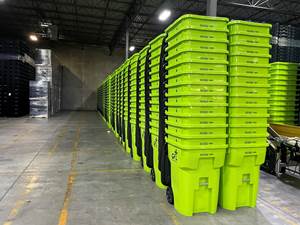Science Shows How Colors Affect Us
Take a look at our September special supplement “Do You Do Color Right?”, and do explore TheGreatCourses.com on color science and so much more.
Take a look at our September special supplement “Do You Do Color Right?”, and do explore TheGreatCourses.com on color science and so much more.
Okay, okay! So, editors tend to be among the population of nerds, those of us in the trade press perhaps even more (and plastics and composites reporters in particular). But, as a listener of podcasts while I take lengthy walks on Connecticut shores or while working out, I can tell you that I’m always learning something.
Sometimes I’m disappointed, but more often than not, I’m ecstatic and end up looking for further information on a particular issue or topic. In the spirit of ‘peace’, and I am a peaceful person, I will not mention politics. However, it is through a couple of interesting podcasts that address politics and science that I heard about TheGreatCourses.com.
Okay…so they are not free (some are pretty costly), but not much is these days. But you might want to check out “How Colors Affect You: What Science Reveals”. It’s a $27.95 video download with six lectures delivered by design expert and University of Houston Professor William Lidwell who explores:
- The history, science, and cultural importance of the six universal colors
- How our brains have evolved to respond to colors without our conscious awareness
- The key experiments that have shaped our understanding of how colors work
- Ways to more effectively apply the science of color to achieve your personal or professional goals for a space.
The course will reportedly open your eyes to why your favorite products practically jump off the shelf; why certain logs are more memorable than others; why particular scenes in nature evoke peace, joy, or fear; and much more.
PT, released this month a supplement, “Do You Do Color Right?” Check out the column introducing it by my colleague, editorial director and assistant publisher Jim Callari. He starts it with: Color. Is it art? Science? Some of both?
Just last week, I blogged about the BASF Color Excellence Group and how they strived to come up with 2020 automotive colors by global region. I think I’d love that job as they travel to-and-from to come up with their ‘scientific’ predictions.
So, back to TheGreatCourses.com color course. It appears that scientists are uncovering secrets on how colors, beyond aesthetics, work on our eyes and our brain…how they influence the way we think, feel, and behave—often without our conscious awareness. The course description describes this as an exciting time in the scientific study of how colors affect us. It points out that knowing how colors affect us informs how we tap into their powers to create environments and achieve a breathtaking range of visual goals. Moreover, it lets us strike down popular myths and misconceptions about color that can easily lead businesses and companies to make costly mistakes. Here are some examples:
• Black uniforms tend to increase aggression and intimidation in conflict situations.
• Red ties can give you an edge in confrontational negotiations, while blue ties can express a desire to collaborate.
• Fire trucks increasingly are painted yellow because that’s the color most visible to our eyes.
• Aligning the right colors to products, brands, and ads can make or break a business’s success.
• Pink rooms will not calm aggressive prisoners or sap the strength of opposing teams.
• Yellow walls in the nursery will not cause babies to cry more often.
• Blue tableware of kitchen walls will not suppress your appetite (although food that’s dyed blue certainly will).

Related Content
Multilayer Solutions to Challenges in Blow Molding with PCR
For extrusion blow molders, challenges of price and availability of postconsumer recycled resins can be addressed with a variety of multilayer technologies, which also offer solutions to issues with color, processability, mechanical properties and chemical migration in PCR materials.
Read MoreRiverdale Global Showing Latest Innovations and New Satellite Location in Wisconsin
NPE2024: Live demos of updated RGS controller are among the highlights at its Wisconsin facility that will house the ‘new’ color R&D lab.
Read MoreGet Color Changes Right In Extrusion Blow Molding
Follow these best practices to minimize loss of time, material and labor during color changes in molding containers from bottles to jerrycans. The authors explore what this means for each step of the process, from raw-material infeed to handling and reprocessing tails and trim.
Read MoreInjection Molder Changes Up Color Changes
An injection molder of trash cans, pallets, totes and other plus-size components, Rehrig Pacific’s machine fleet is composed of larger tonnage presses whose size makes material changes at the feed throat a potentially dizzying exercise.
Read MoreRead Next
Beyond Prototypes: 8 Ways the Plastics Industry Is Using 3D Printing
Plastics processors are finding applications for 3D printing around the plant and across the supply chain. Here are 8 examples to look for at NPE2024.
Read MoreFor PLASTICS' CEO Seaholm, NPE to Shine Light on Sustainability Successes
With advocacy, communication and sustainability as three main pillars, Seaholm leads a trade association to NPE that ‘is more active today than we have ever been.’
Read MoreSee Recyclers Close the Loop on Trade Show Production Scrap at NPE2024
A collaboration between show organizer PLASTICS, recycler CPR and size reduction experts WEIMA and Conair recovered and recycled all production scrap at NPE2024.
Read More


























